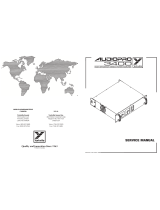Page is loading ...

Alluring Echo
Splendid modulated
tape-style delay
Contents of this document are ©2022 Pedal Parts Ltd.
No reproduction permitted without the express written
permission of Pedal Parts Ltd. All rights reserved.

Important notes
If you’re using any of our footswitch daughterboards,
DOWNLOAD THE DAUGHTERBOARD DOCUMENT
•Download and read the appropriate build document for the daughterboard
as well as this one BEFORE you start.
•DO NOT solder the supplied Current Limiting Resistor (CLR) to the main
circuit board even if there is a place for it. This should be soldered to the
footswitch daughterboard.
POWER SUPPLY
Unless otherwise stated in this document this circuit is designed to be
powered with 9V DC.
COMPONENT SPECS
Unless otherwise stated in this document:
•Resistors should be 0.125W. You can use those with higher ratings but
check the physical size of them. 0.4W can also be found in 3mm length.
•Electrolytics caps should be at least 25V for 9V circuits, 35V for 18V
circuits. Again, check physical size if using higher ratings.
LAYOUT CONVENTIONS
Unless otherwise stated in this document, the following are used:
•Electrolytic capacitors:
Long leg (anode) to square pad.
•Diodes/LEDs:
Striped leg (cathode) to square pad. Short leg to square pad for LEDs.
•ICs:
Square pad indicates pin 1.

Schematic + BOM
R1 1M
R2 100K
R3 47K
R4 10K
R5 10K
R6 12K
R7 1K
R8 100K
R9 10K
R10 10K
R11 10K
R12 15K
R13 10K
R14 Jumper*
R15 10K
R16 10K
R17 1K
R18 10K
R19 120K
R20 220K
R21 120K
R22 220K
R23 4K7
R24 100K
R25 4K7
R26 4K7
R27 1K
R28 47K
R29 47K
R30 100R
R31 220K**
C1 100n
C2 47p
C3 47n
C4 1u
C5 1u
C6 1u
C7 2n2
C8 2n2
C9 100n
C10 330n
C11 22n
C12 100n
C13 100n
C14 100n
C15 10n
C16 Empty*
C17 1u
C18 1u
C19 22n
C20 10u elec
C21 4u7 elec
C22 100n
C23 47u elec
C24 100u elec
C25 47u elec
C26 100u elec
C27 100u elec
IC1 PT2399
IC2 OPA2134
IC3 LM358
U1 78L05
D1-2 1N4148
D3 1N5817
D4 LED
DEP 100KB
GAIN 100KB/TRIM
LVL 100KB
REG 100KA
SPD 50KB
TIM 50KB*
T1 10K TRIM
*Extended delay time mod - R14 10K, C16 10n, TIM 100KB. Repeats will have more noise.
**Missing from the board and needs to be hacked in. See later in doc.
You can use an external pot for gain if you like, but it’s best to set and forget with a trimmer.


The power and signal pads on the PCB
conform to the FuzzDog Direct Connection
format, so can be paired with the appropriate
daughterboard for quick and easy offboard
wiring. Check the separate daughterboard
document for details.
Be very careful when soldering the diodes, U1
and LED. They’re very sensitive to heat. You
should use some kind of heat sink (crocodile
clip or reverse action tweezers) on each leg as
you solder them. Keep exposure to heat to a
minimum (under 2 seconds). Same goes for
the ICs if you aren’t using sockets.
You should solder all other board-mounted
components before you solder the pots. Once
they’re in place you’ll have no access to much
of the board. Make sure your pots all line up
nicely.
The best way to do that is to solder
a single pin of each pot in place then melt and
adjust if necessary before soldering in the
other two pins. If your pots don’t have
protective plastic jackets ensure you leave a
decent gap between the pot body and the PCB
otherwise you risk shorting out the circuit.
There are extra pads for the Gain trimmer so
you can use different types. As long as there’s
a leg in each column marked above you’re OK.
D4 will get brighter when the modulation
depth is higher, and will flash to indicate the
modulation speed.
PCB layout ©2022 Pedal Parts Ltd.

R31 Hack
Oops. It’ll be fixed on V1.1 of the PCB, but for now this needs to be hacked in. It’s simple.
Leave some of the leg of R19 above the board when mounting. When everything else is assembled
simple place R31 from the exposed leg of R19 to pin 1 of the SPD pot, above D3.
Adjusting the trimmers
GAIN - turn all the controls down to zero. Adjust the trimmer until your engaged signal is the same
level as your bypassed signal, or louder if you want some boost.
T1 adjusts the overall modulation depth. Tweak to taste. There’s no right or wrong.

Test the board!
Check the relevant daughterboard document for more
info before you undertake this stage.
UNDER NO CIRCUMSTANCES will troubleshooting help
be offered if you have skipped this stage. No exceptions.
Once you’ve finished the circuit it makes sense to test is before starting on the switch and LED
wiring. It’ll cut down troubleshooting time in the long run. If the circuit works at this stage, but it
doesn’t once you wire up the switch - guess what? You’ve probably made a mistake with the switch.
Solder some nice, long lengths of wire to the board connections for 9V, GND, IN and OUT. Connect
IN and OUT to the jacks as shown. Connect all the GNDs together (twist them up and add a small
amount of solder to tack it). Connect the battery + lead to the 9V wire, same method. Plug in. Go!
If you’re using a ribbon cable you can tack the wires to the ends of that. It’s a lot easier to take them
off there than it is do desolder wires from the PCB pads.
If it works, carry on and do your switch wiring. If not... aw man. At least you know the problem is
with the circuit. Find out why, get it working, THEN worry about the switch etc.
Your completed circuit board
including pots

Wiring shown above will disconnect the battery when you remove the jack plug
from the input, and also when a DC plug is inserted.
The Board GND connections don’t all have to directly attach to the board. You
can run a couple of wires from the DC connector, one to the board, another to
the IN jack, then daisy chain that over to the OUT jack.
It doesn’t matter how they all connect, as long as they do.
This circuit is standard, Negative GND. Your power supply should be Tip
Negative / Sleeve Positive. That’s the same as your standard pedals (Boss etc),
and you can safely daisy-chain your supply to this pedal.
L
E
D
BOARD
OUT
BOARD
9V
BOARD
GND
BOARD
GND
BOARD
GND
BOARD
INPUT
BATTERY
+
IN
OUT
L
E
D
BOARD
GND
BOARD
9V
+
Wire it up (if using a daughterboard please refer to the relevant document)

This template is a rough guide only. You should ensure correct marking of your
enclosure before drilling. You use this template at your own risk.
Pedal Parts Ltd can accept no responsibility for incorrect drilling of enclosures.
FuzzDog.co.uk
Drilling template
Hammond 1590B
60 x 111 x 31mm
It’s a good idea to drill the pot and
toggle switch holes 1mm bigger if
you’re board-mounting them.
Wiggle room = good!
Recommended drill sizes:
Pots 7mm
Jacks 10mm
Footswitch 12mm
DC Socket 12mm
Toggle switches 6mm
35.5mm
27mm
/
















